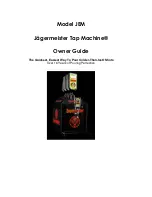
3
SPECIFICATIONS
Model
IDP30S
IDP40S
IDP40CC
*
IDP50CC
*
Model Code
ID30S
ID40S
ID40C
ID50C
Rated Softening Capacity
(grains @ lb. salt dose)
12,000 @ 2.4
25,600 @ 7.5
30,600 @ 12.6
11,800 @ 2.4
31,600 @ 9.0
40,000 @ 15.5
11,800 @ 2.4
31,600 @ 9.0
40,000 @ 15.5
16,600 @ 3.3
44,300 @ 12.3
56,300 @ 21.3
Rated Efficiency
(grains / lb. @ minimum salt dose)
5,090 @ 2.4
4,950 @ 2.4
4,980 @ 2.4
5,090 @ 3.3
Water Used During Regeneration @
Minimum Salt Dose
2.5 gal. /
1,000 grains
3.1 gal. /
1,000 grains
4.1 gal. /
1,000 grains
4.5 gal. /
1,000 grains
Amount of High Capacity Resin
0.79 cu. ft.
1.13 cu. ft.
1.13 cu. ft.
1.56 cu. ft.
Amount of Catalytic Carbon
–
–
0.40 cu. ft.
0.57 cu. ft.
Amount of Gravel
–
–
–
12 lbs.
Service Flow Rate
7.2 gpm
8.0 gpm
4.0 gpm
5.0 gpm
Pressure Drop at Rated Service Flow
15.0 psig
8.5 psig
10.0 psig
10.0 psig
Intermittent Flow @ 15 psi
p
7.2 gpm
11.7 gpm
15.0 gpm
15.0 gpm
Intermittent Flow @ 30 psi
p
11.0 gpm
18.1 gpm
21.0 gpm
21.0 gpm
Water Supply Maximum Hardness
50 gpg
65 gpg
65 gpg
85 gpg
Water Supply Maximum
Clear Water Iron
¢
6 ppm
8 ppm
8 ppm
10 ppm
Min. - Max. Water Supply Pressure
u
20 - 125 psi
Min. - Max. Water Supply Temperature
40 - 120 °F
Minimum Water Supply Flow Rate
3 gpm
Max Drain Flow Rate
2.0 gpm
p
Intermittent flow rate does not represent the maximum service flow rate used for determining the unit’s rated capacity
and efficiency. Continuous operation at flow rates greater than the service flow rate may affect capacity and efficiency
performance.
¢
Capacity to remove clear water iron is substantiated by independent laboratory test data. State of Wisconsin requires
additional treatment if water supply contains greater than 5 ppm clear water iron.
u
Canada working pressure limits: 1.4 - 7.0 kg/cm².
Ù
Models IDP40CC & IDP50CC have not been tested or certified by NSF International or the Water Quality Association.
These units conform to NSF/ANSI 44 for the specific performance claims as verified and substantiated by test data.
These models are efficiency rated. The efficiency rating is valid only at the minimum salt dose and the service flow
rate. The softeners have a demand initiated regeneration (D.I.R) feature that complies with specific performance
specifications intended to minimize the amount of regenerant brine and water used in their operation.
These softeners have a rated softener efficiency of not less than 3,350 grains of total hardness exchange per pound
of salt (based on sodium chloride) and shall not deliver more salt than their listed rating or be operated at a sus-
tained maximum service flow rate greater than their listed rating. These softeners have been proven to deliver soft
water for at least ten continuous minutes at the rated service flow rate. The rated salt efficiency is measured by lab-
oratory tests described in NSF/ANSI Standard 44. These tests represent the maximum possible efficiency that the
system can achieve. Operational efficiency is the actual efficiency after the system has been installed. It is typically
less than the rated efficiency, due to individual application factors including water hardness, water usage, and other
contaminants that reduce a softener's capacity.
While testing was performed under standard laboratory conditions, actual performance of the system may vary
based on local water conditions.
Specifications




































